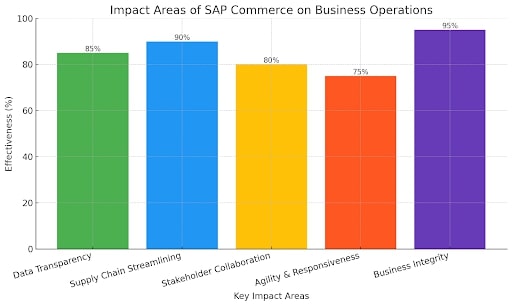How SAP Commerce and Adobe Commerce Solutions Are Shaping the Landscape
Choosing the right platform to become an e-commerce powerhouse.

Introduction
In a time of quick tech growth, the digital commerce area is very important for business growth and customer connection. As companies focus more on smooth online experiences, they are relying more on strong eCommerce platforms, leading to a closer look at leaders like SAP Commerce and Adobe Commerce.
These options provide a lot of features and encourage new ideas by adding advanced tools like personalized shopping and in-depth analytics. The importance of these platforms is highlighted by industry reviews, like the quadrant chart, showing their competitive stance among digital commerce solutions in 2024.
This chart highlights the growing importance of Adobe Commerce next to well-known names, showing that businesses must adjust and use these technologies. In the end, the development of these platforms is changing the digital commerce scene, changing how companies engage with customers in a much more competitive market.
Overview of SAP Commerce and Adobe Commerce Solutions in the E-commerce Landscape
The changing e-commerce environment requires strong platforms that can quickly adapt to business needs. In this situation, both SAP Commerce and Adobe Commerce Solutions offer good options for companies looking to improve their online retail presence. SAP Commerce is notable for its wide integration abilities, which enable smooth connections between various channels and stakeholders, helping create the transparency needed for good decision-making and improved operations (ERP systems facilitating XBRL reporting and regulatory compliance.).
On the other hand, Adobe Commerce, which used to be called Magento, features advanced personalization tools that allow sellers to provide unique customer experiences, an important factor in today’s customer-focused market. Comparing these two platforms shows their different yet helpful strengths, meeting various organizational demands. Moreover, the visual representation of the framework, like the quadrant chart showing Adobe Commerce’s position among top digital platforms in 2024, highlights its advantage in the market.
| Platform | MarketShare | AnnualGrowthRate | KeyFeatures |
|---|---|---|---|
| SAP Commerce | 15% | 8% | Personalization, API Integration, Scalability |
| Adobe Commerce | 10% | 7% | Robust Analytics, Customization, Marketing Tools |
| Shopify | 30% | 10% | Ease of Use, App Ecosystem, Pricing Flexibility |
| WooCommerce | 25% | 6% | WordPress Integration, Extensive Plugins, Cost-Effective |
| Magento (Open Source) | 10% | 5% | Customizable, Community Support, Strong SEO |
E-commerce Platform Market Share (2023)
The Impact of SAP Commerce on Business Operations
In the fast-changing business world, companies need to use advanced digital tools to stay competitive. SAP Commerce has a big impact on business activities by improving data clarity and making supply chain processes more efficient. By providing accurate and timely information, SAP Commerce makes sure that important data moves smoothly between all parties, which is crucial for good decision-making.
This information needs to be shared among people in the organization, its suppliers and customers, as well as outside government and regulatory agencies, showing how important clear data is for business integrity (ERP systems facilitating XBRL reporting and regulatory compliance). Also, the move toward integrated commerce solutions shows a larger trend in companies wanting to bring together different operations into unified systems that enhance flexibility and quick responses (An internal analysis of salesforce and the motives leading to the possible acquisition of slack). So, using SAP Commerce not only improves operations but also builds a culture of trust and teamwork among stakeholders, changing how companies function in the digital era.

Streamlining Supply Chain Management and Customer Experience
In today's business world, merging supply chain management with customer experience is very important for gaining a competitive edge. Using tools like SAP Commerce and Adobe Commerce not only improves operational efficiency but also enhances how customers interact with businesses. A vital part of this connection is sharing information accurately and on time throughout the supply chain, which must be cost-effective and trustworthy as required by the global economy (ERP systems facilitating XBRL reporting and regulatory compliance). Also, the difficulty of adding new technologies like Blockchain into older CRM systems shows the changes needed to meet new demands for transparency and traceability (When Blockchain Meets CRM: An Evaluation of Enterprise CRM Vendor Blockchain Capabilities). The view of market dynamics, shown in , gives stakeholders important insights into key digital commerce frameworks—this is a crucial move for businesses looking to align their supply chain plans with customer needs. This alignment boosts loyalty and increases profits in a marketplace that is becoming more and more digital.
The Role of Adobe Commerce in Enhancing Digital Marketing Strategies
Integrating Adobe Commerce into digital marketing strategies makes eCommerce efforts better. By using strong data analysis and personalized marketing tools, Adobe Commerce helps businesses adjust their offerings to fit consumer needs. The platform allows for smooth customer experiences through using contextual data and advanced segmentation, making sure that marketing messages connect with target groups. Also, as shown in , Adobe Commerce’s place among top digital commerce platforms shows it can serve both large enterprises and small-to-medium businesses. This approach lets companies of all sizes create complete marketing plans that match their specific business needs. As digital environments keep changing, effective data management, as mentioned in (ERP systems facilitating XBRL reporting and regulatory compliance), is critical for upholding transparency and trust, highlighting Adobe Commerce’s role in effective digital marketing.
Integration of Personalization and Customer Engagement Tools
As companies deal more with the problems of online business, the mix of personalization and tools for customer engagement becomes a key factor for improving consumer satisfaction and loyalty. By combining these tools well, businesses can provide unique experiences that match what individual customers want, which boosts engagement. The growth of artificial intelligence has changed how companies market; using data analysis, they can use insights to create immediate, personalized interactions that meet customer needs across different channels. For example, retailers can use advanced technologies like big data to form complete customer profiles, making targeted marketing campaigns that improve conversion rates. These methods support findings about the need for customer connection, highlighted by (Digital marketing in retail : what are the benefits a Swiss premium department store could reap when adapting to the changing environment of digitization? A maturity model) and shown in the changing landscape of lead management seen in (Marketing Automation & AI Report 2024 : tactics & tools of AI-based lead generation). Also, visual insights help platforms like Adobe Commerce become leaders in the industry by using these integrated tools effectively.
Conclusion
The analysis of SAP Commerce and Adobe Commerce shows how important they are for changing the digital marketplace, helping businesses adjust to fast-changing consumer needs. More and more, organizations depend on these platforms to use customer data, making it essential to understand how these digital tools affect building relationships in B2B situations. It is clear that informed customers can help create value, which highlights the need to use customer knowledge to improve marketing and sales efforts (Digitalization and new buyer behavior changing b2b relationship marketing). Additionally, the rise of low-code and no-code tools means technology is becoming more accessible, giving companies the ability to innovate and quickly adapt to market changes ("The "Good Enough" Tsunami : The Disruptive Potential of Low-code and No-code : A multiple case-study on scope, trends, and implications). The visualization provided in highlights the competitive environment, showing that these platforms are not just tools but key players in driving strategic change in commerce.
Future Implications of SAP and Adobe Commerce Solutions in E-commerce Development
As the online business world keeps changing, using advanced tools like SAP and Adobe Commerce is key for companies that want to do well in e-commerce. One big benefit of these platforms is that they improve customer experiences through smart data analysis and customized engagement methods. By using real-time data, businesses can adjust their products to fit what different consumer groups need, which helps build brand loyalty and boost sales. Also, the teamwork features of these tools make work processes easier, allowing companies to quickly react to market trends and customer needs. This flexibility is important in a fast-changing digital economy. To show this change, the quadrant chart in below displays Adobe Commerce’s strong position among top platforms for business capabilities and market reach, highlighting its vital part in shaping future strategies for e-commerce development.

Image1. Analysis of Digital Commerce Platforms in 2024
References
- Schöni, Pascal. "Digital marketing in retail: what are the benefits a Swiss premium department store could reap when adapting to the changing environment of digitization? A maturity model" ZHAW Zürcher Hochschule für Angewandte Wissenschaften, 2017
- Cantin, Virginie, Gasser, Marc, Kölle, Daniel, Rettenmund, et al. "Marketing Automation & AI Report 2024: tactics & tools of AI-based lead generation" ZHAW Zürcher Hochschule für Angewandte Wissenschaften, 2024
- Olsson, Tobias, Uhlin, Emil. "Digitalization and New Buyer Behavior is Changing B2B Relationship Marketing" Lunds universitet/Produktionsekonomi, 2015
- Paulsen, June Blydt, Smedsrud, Helle Låhne. "The 'Good Enough' Tsunami: The Disruptive Potential of Low-code and No-code: A multiple case-study on scope, trends, and implications" 2023
- Santos, Mariana Lopes Cravo Plancha dos. "An internal analysis of salesforce and the motives leading to the possible acquisition of slack" 2023
- Kloeden, Phillip. "ERP systems facilitating XBRL reporting and regulatory compliance" RIT Scholar Works, 2007
- Abooleet, Saeed, Kinnett, Seth J. "When Blockchain Meets CRM: An Evaluation of Enterprise CRM Vendor Blockchain Capabilities" AIS Electronic Library (AISeL), 2022
- Kloeden, Phillip. "ERP systems facilitating XBRL reporting and regulatory compliance" RIT Scholar Works, 2007
- Kloeden, Phillip. "ERP systems facilitating XBRL reporting and regulatory compliance" RIT Scholar Works, 2007
- Santos, Mariana Lopes Cravo Plancha dos. "An internal analysis of salesforce and the motives leading to the possible acquisition of slack" 2023
- Kloeden, Phillip. "ERP systems facilitating XBRL reporting and regulatory compliance" RIT Scholar Works, 2007
- Santos, Mariana Lopes Cravo Plancha dos. "An internal analysis of salesforce and the motives leading to the possible acquisition of slack" 2023


